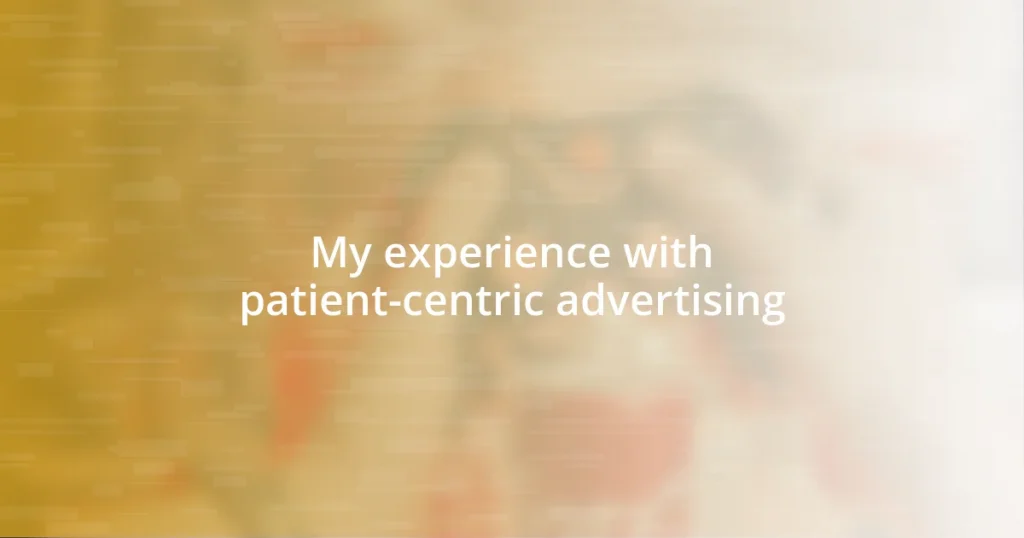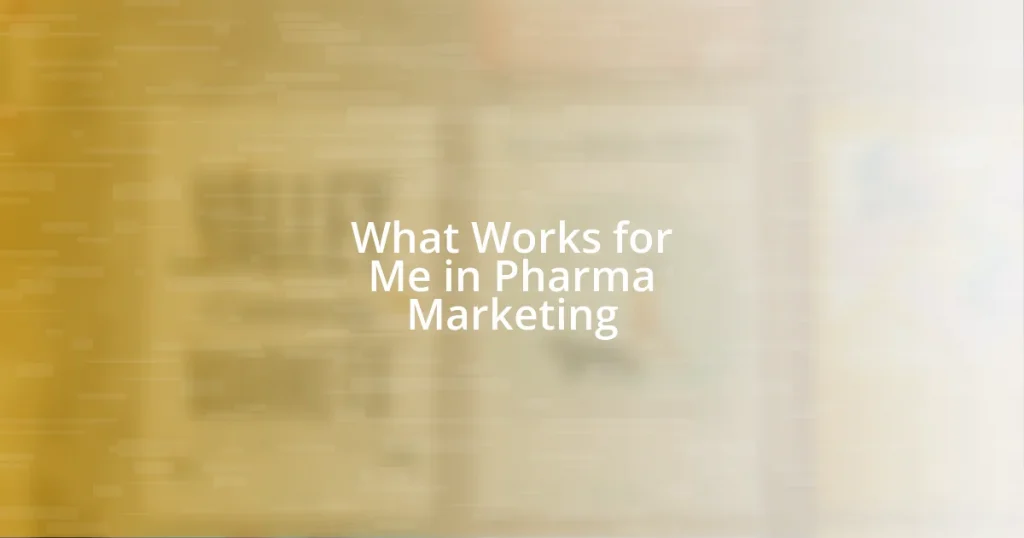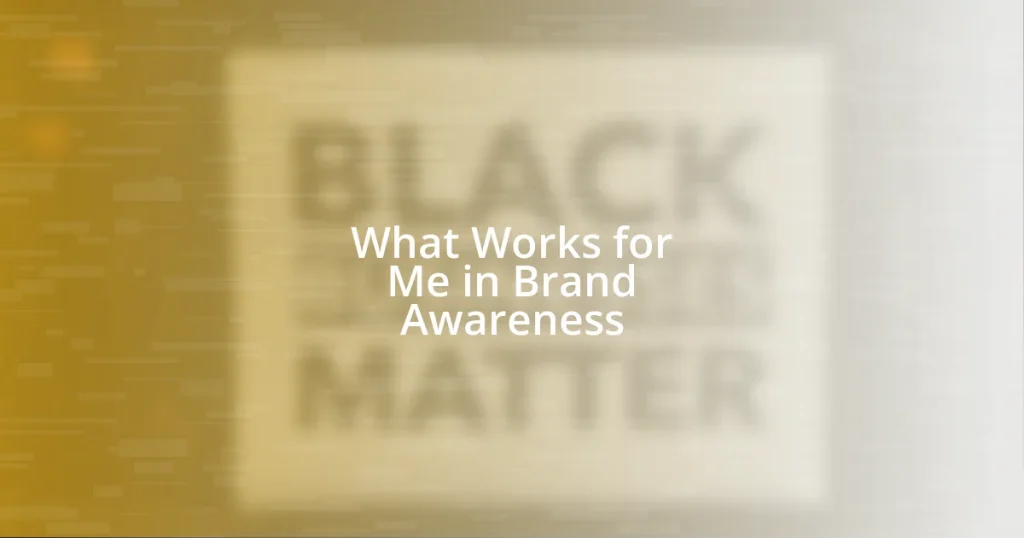Key takeaways:
- Patient-centric advertising prioritizes understanding patients’ real experiences, fostering emotional connections that improve engagement and health outcomes.
- Utilizing both qualitative and quantitative data allows marketers to create more relatable and effective campaigns that address patient’s day-to-day realities.
- Transparency and patient involvement in the advertising process build trust, encouraging loyalty and advocacy within patient communities.

Introduction to patient-centric advertising
Patient-centric advertising is an approach that puts the needs and experiences of patients at the forefront of marketing strategies. I remember attending a conference where a speaker shared a heartfelt story about a patient who felt invisible in the healthcare system; this personal touch left a lasting impression on me. It made me realize that understanding patients’ journeys and feelings is critical to creating effective advertisements.
When I think about patient-centric advertising, I’m reminded of those moments when I’ve received marketing messages that truly resonated with my own health experiences. Have you ever felt like an ad was speaking directly to you? That’s the power of crafting campaigns that not only inform but also empathize with patients’ struggles, hopes, and aspirations. Such targeted messaging can bridge the gap between healthcare providers and the individuals they seek to help.
Incorporating real stories and clear dialogues into advertising not only builds trust but also fosters a sense of community among patients. It’s about shifting the narrative from what companies want to sell to understanding what patients genuinely need. I’ve witnessed firsthand how campaigns grounded in empathy can drive engagement, promote adherence to treatment plans, and ultimately lead to better health outcomes.

Importance of understanding patient needs
Understanding patient needs is not just a box to check; it’s the backbone of effective patient-centric advertising. From my experience, when marketers genuinely listen to patients, they uncover invaluable insights that can shape campaigns in profound ways. For instance, I once collaborated on a campaign aimed at individuals managing chronic pain. We conducted interviews, and the patients shared their struggles with isolation and the lack of relatable support. This input transformed the campaign, allowing us to connect authentically with our audience.
I vividly recall an advertising initiative that revolved around mental health support. The core message was built on real patient stories, and the response was overwhelming. Patients felt seen and heard. Those who interacted with our content often expressed gratitude for finally encountering an ad that reflected their experiences. This emotional connection is crucial; it highlights that understanding patient needs goes beyond demographics—it’s about their day-to-day realities and hopes.
Ultimately, when organizations prioritize understanding patient needs, they create campaigns that resonate deeply. I have seen how this approach not only fosters loyalty but also contributes to a more compassionate healthcare narrative. After all, marketing is more effective when it feels like a conversation where the patient is at the center, expressing their fears and joys without hesitation.
| Understanding Patient Needs | Traditional Advertising Approaches |
|---|---|
| Focuses on emotional stories and real experiences | Primarily centered around product features and benefits |
| Encourages patient engagement and community | Often alienates patients by ignoring their journey |
| Builds trust with relatable messaging | Can create skepticism with generic or persuasive tactics |

Key strategies for effective advertising
When I reflect on essential strategies for effective patient-centric advertising, a few key principles consistently stand out. One memorable project involved partnering with a non-profit organization to raise awareness about diabetes management. We focused on making the advertisements relatable, illustrating real-life scenarios that many patients faced daily. By using simple, clear language, we ensured the message was accessible, inviting individuals to see themselves in the campaign. This approach not only generated interest but also empowered patients to take charge of their health journey.
- Utilize relatable storytelling: Sharing real patient experiences resonates deeply, fostering a connection that statistics simply cannot achieve.
- Simplify language and visuals: Avoiding complex medical jargon allows for clearer communication, ensuring that messages are easily understood.
- Encourage patient interaction: Incorporating feedback loops where patients can share their insights creates a collaborative environment, enhancing trust and engagement.
Each of these strategies reinforces the idea that advertising should not feel like a monologue but rather a dialogue, one where the voices of patients are amplified and celebrated. It’s astonishing how much depth and connection can emerge when we invite patients to be part of the narrative.

Utilizing data for patient insights
Utilizing data effectively can transform how we glean insights about patients. For instance, during a project aimed at enhancing patient adherence to medication, we analyzed surveys that revealed many patients felt overwhelmed by their treatment plans. This information led us to create educational materials that simplified complex regimens into intuitive formats, making a real difference in patient compliance. Isn’t it fascinating how data can illuminate such pivotal gaps in understanding?
Moreover, I’ve seen how digital health platforms offer rich behavioral data—everything from app usage patterns to symptom tracking. A recent collaboration with a health app highlighted that users often disengaged when faced with technical jargon or lengthy procedures. By adjusting our communications based on these insights, we were able to boost user engagement significantly. The impact was tangible, proving that decisions fueled by data lead to more responsive and patient-friendly approaches.
Lastly, I find that combining qualitative and quantitative data yields the most profound insights. For instance, after focusing on both the statistical reports from patient health records and the narratives collected from focus groups, we developed nuanced messages that resonated on multiple levels. This multi-faceted understanding allowed us to create a campaign that not only educated but also inspired. Have you ever thought about the power of merging different types of data to get a fuller picture of patient needs? The results can be truly enlightening.

Building trust through transparency
Building trust in patient-centric advertising hinges significantly on transparency. I recall a campaign where we openly shared our research methods and results with patients. This approach was not typical in our industry, but it sparked meaningful conversations. Patients appreciated knowing how we gathered insights, and they felt more confident in our messaging. Isn’t it powerful when transparency transforms skepticism into trust?
Moreover, I’ve learned that admitting our limitations can actually strengthen relationships with patients. In one instance, we communicated openly about the complexities of treatment options. Acknowledging that there isn’t always a ‘one-size-fits-all’ solution resonated with many who had been frustrated by the oversimplification of their conditions in other advertisements. It made our campaign feel genuine—something I’ve seen foster deeper loyalty among patients.
Trust also grows when we involve patients in the process. For a recent initiative, we invited a small group of patients to review our messaging and provide feedback. They greatly appreciated being part of the conversation, and their insights helped us refine our approach. When patients feel heard and valued, it not only boosts their confidence in our communications but also encourages them to advocate for us within their communities. Have you ever encountered an experience where being open and genuine transformed a relationship for the better? It’s enlightening how such interactions can shape perceptions and foster lasting connections.

Case studies of successful campaigns
One standout case study that comes to mind is a campaign aimed at diabetes management, where we harnessed the power of storytelling. We partnered with real patients who shared their journeys with the disease through video testimonials. Their authentic narratives resonated deeply with others facing similar challenges, creating an emotional connection that statistics alone couldn’t achieve. Isn’t it remarkable how personal stories can bridge the gap between clinical data and real-life experiences?
Another example I vividly recall was an initiative for a new migraine medication. Here, we utilized social media to host live Q&A sessions featuring headaches specialists. Patients were encouraged to ask questions directly, and I witnessed the shift in engagement levels as confusion turned into clarity. Patients shared their relief at finally having a platform for their voices. It reinforced my belief that creating open channels is crucial; after all, who doesn’t want their concerns addressed in real-time?
Lastly, the campaign for a rare disease treatment is one that left a profound mark on me. We collaborated with patient advocacy groups to ensure our messaging was not just accurate, but also meaningful to those affected. The feedback sessions opened my eyes to the enormity of representation in advertising. When we showcased real experiences, it infused our campaign with genuine empathy. Have you ever felt that a brand truly understood your struggles? That connection is what can make a campaign not just successful, but truly memorable.

Future trends in patient-centric advertising
As I look towards the future of patient-centric advertising, I can’t help but feel excited about the potential of technology-driven personalization. Imagine receiving advertising that not only showcases a product but tailors content based on your specific health needs and preferences. I recently saw an example of this when a healthcare provider sent personalized videos to patients based on their treatment history. This level of attention felt like an invitation to engage, rather than just a marketing push. The question is: how can we leverage data responsibly to build deeper connections?
In my experience, digital communities are evolving into a significant platform for patient engagement. I remember a time when we launched a campaign on an online health forum, allowing patients to share their experiences and support one another. The interaction was rich and heartfelt. It made me realize that advertising could shift from a one-way communication model to a thriving ecosystem of shared experiences. It’s a refreshing thought—how can we ensure these platforms are nurtured to foster genuine conversations?
Another trend I see emerging is the integration of mental health into overall wellness advertising. A few years back, a campaign focused on chronic illness highlighted the emotional toll, resonating with many who felt isolated in their struggles. I found this approach transformative; it wasn’t just about physical health—it addressed a holistic view of well-being. Doesn’t it make sense to normalize discussions around mental health in our advertising, to help break down those barriers? Ultimately, I believe this focus will not only enhance patient trust but also deepen the impact of our messaging.















